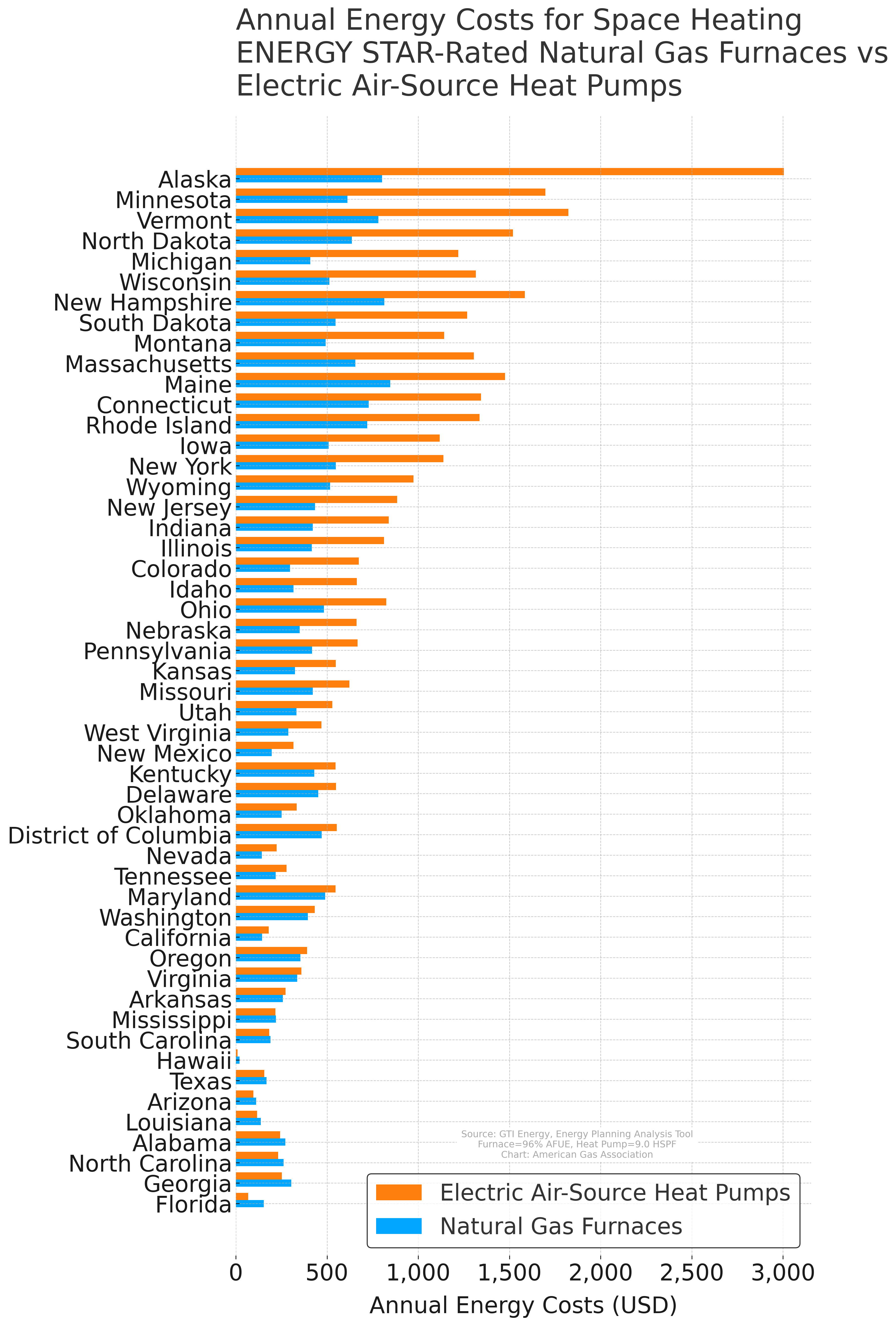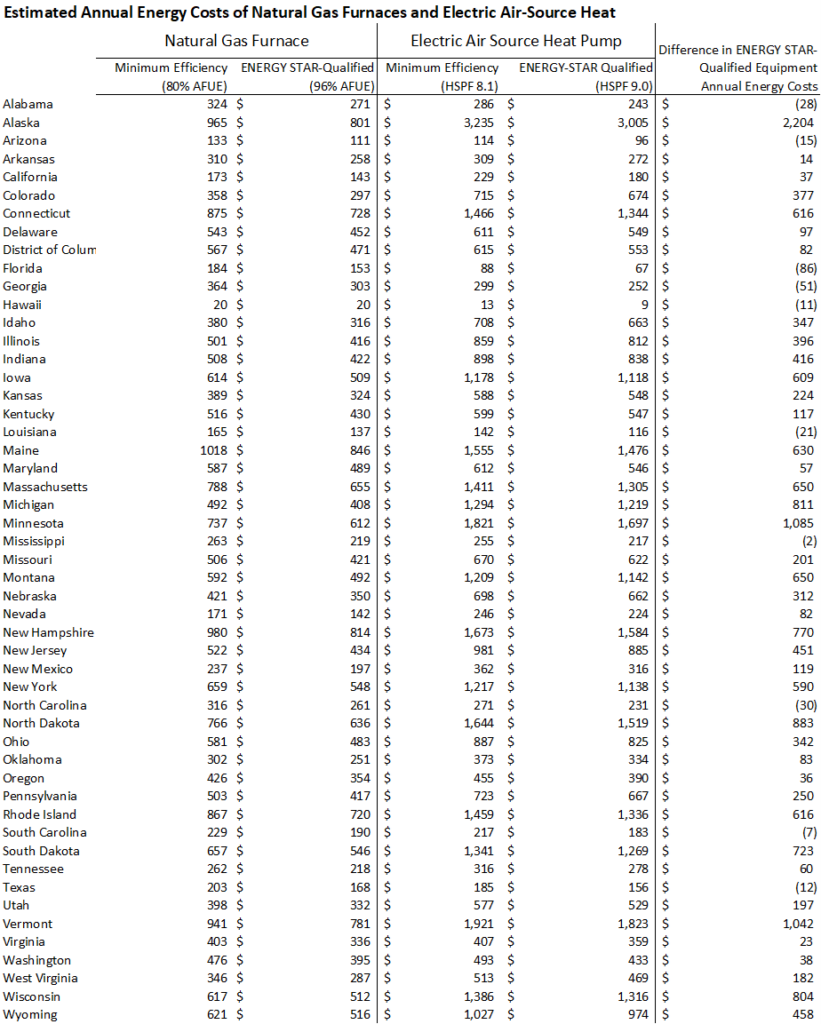Energy Insights: Evaluating Annual Energy Costs of ENERGY STAR Equipment
This AGA Energy Analysis examines the annual energy costs associated with high-efficiency gas and electric equipment, focusing on ENERGY STAR-qualified electric air source heat pumps and ENERGY STAR-qualified natural gas furnaces. The Energy Planning Analysis Tool from GTI Energy provided the basis for estimating annual energy requirements and costs.[1]

Findings
- In 41 out of 50 states, ENERGY-STAR-qualified natural gas furnaces lead to lower annual energy costs than their electric air-source heat pump counterparts. This trend holds even when comparing minimum-efficiency natural gas furnaces to ENERGY STAR electric heat pumps, with the former being more economical in 36 states.
- There is a significant variation in the cost difference between electric and gas heating across different states. This variability highlights the influence of local energy prices and climate conditions.
- Electric heating tends to be substantially more expensive than gas in colder states like Alaska, Minnesota, and Vermont. For example, Minnesota shows a high difference, with electric heating costing, on average, $1,085 more annually than gas.
- High-efficiency electric and natural gas heating have similar annual energy costs in several states, particularly those with milder climates. Still, the cost difference is much smaller than in the colder states. Electric heat pumps may produce modest cost savings relative to a natural gas furnace in some states with warm climates.
- Upgrading to an ENERGY STAR natural gas furnace from a minimum-efficiency model yields energy savings and emissions reductions in all 50 states.
- The annual energy costs presented here are unaffected by new federal or state incentives for heating equipment purchases.
Considerations
Residential space heating requirements are influenced by various factors linked to local climate and weather patterns, building characteristics, energy prices and policies, reliability and convenience, consumer behavior, and heating system efficiency. The type and efficiency of the heating system play a pivotal role in shaping end-use energy requirements and costs. High-efficiency natural gas appliances are often the most cost-effective and lowest emissions option for consumers.[2]
These results indicate that consumers require options for their home heating needs. Improving energy efficiency regardless of fuel type provides consumer cost benefits in addition to energy and emissions reductions. Policymakers should prioritize educating consumers and facilitating informed energy choices tailored to individual circumstances and regional needs.
Additional Information
Energy Planning and Analysis Tool
The Energy Planning Analysis Tool is a screening tool to evaluate the potential implications of electricity and fuel use in residential applications. The EPAT compares an annual snapshot for residential appliances in specific locations and allows users to evaluate the cost, energy consumption, and emissions of energy and appliance options. This analysis evaluates the annual energy costs of operating an ENERGY STAR-qualified natural gas AFUE 96% furnace and electric 16 SEER/9.0 HSPF heat pump operating in 50 states. This analysis does not present air conditioning loads or cost estimates. This analysis did not examine all factors that shape home energy decisions, including upfront costs and other economic factors, energy availability and accessibility, environmental concerns, and government policies and incentives.
The Environmental Protection Agency ENERGY STAR Program
The ENERGY STAR program was initiated as a voluntary labeling program to identify and promote energy-efficient products, homes, buildings, and manufacturing plants. Created under the auspices of the 1992 Clean Air Act, the program was formalized with broader authority through the 2005 Energy Policy Act. The U.S. Environmental Protection Agency and the U.S. Department of Energy jointly manage the program. The program’s intended purpose is to reduce energy consumption, promote utility cost savings, and reduce pollution and greenhouse gas emissions. The program’s emblem has since become a hallmark for energy-saving appliances, guiding consumers and organizations towards choices that lower energy costs and reduce the environmental footprint. Within this framework, natural gas appliances, including boilers and furnaces, have been recognized under the ENERGY STAR specification, denoting their efficiency and lower emissions.
However, an EPA proposal to remove these appliances from the program’s specifications could have several negative consequences. Removing the ENERGY STAR label from natural gas equipment could lead to a decrease in adopting higher-efficiency gas equipment, as consumers may opt for lower-efficiency options due to first-cost burdens.[3]

Assumes Average State Energy Prices (EIA)
[1] GTI Energy, Energy Planning and Analysis Tool, https://cmicepatcalc.gti.energy/
Tool description: https://cmicepatcalc.gti.energy/ToolDescription.pdf
[2] “Comparison of Home Appliance Energy Use, Operating Costs, and Carbon Dioxide Emissions 2022 Update.” American Gas Association, https://www.aga.org/research-policy/resource-library/energy-insights-comparison-of-home-appliance-energy-use-operating-costs-and-carbon-dioxide-emissions/
[3] “Empowering Consumer Choices: Analyzing the Impact of the ENERGY STAR Program on the Adoption of High-Efficiency Gas Appliances.” American Gas Association. June 2023. https://www.aga.org/wp-content/uploads/2023/06/AGA-Energy-Insights-Empowering-Consumer-Choices-Analyzing-the-Impact-of-the-ENERGY-STAR-Program-on-the-Adoption-of-High-Efficiency-Gas-Appliances.pdf
Download the report here: